
Battle of Munfordville
"Battle of Munfordville, Ky., Sunday, September 14th, 1862- the Confederates charging through the abatis…

Conrad's Ferry
"Conrad's Ferry, Md., above Harrison's Island, on the Potomac River, the place of passage of Colonel…
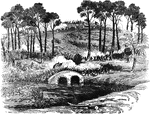
Battle of Antietam
"Battle of Antietam, Md. Burnside's division carrying the bridge over the Antietam Creek and storming…

Bird's Point
"View of the fortifications erected by the Federal troops at Bird's Point, MO., opposite Cairo, Ill."—…

Fort Thompson
"Bombardment and capture of Fort Thompson, thirteen guns, near New Berne, on the Neuse River, by the…

Columbus, Kentucky
"General view of Columbus, Ky., and its fortications, looking down the river, showing the 'Iron Bluffs'…

Paducah, Kentucky
"View of the town of Paducah, Ky., at the confluence of the rivers Ohio and Tennessee, the Northern…

Confederate Schooner
"Bird's-eye view of the burning of a Confederate schooner in Quantico or Dumfries Creek, Potomac River,…
Fort Clinch
"Exterior view of Fort Clinch, on Amelia Island, Fla., commanding the Harbor of Fernandina, captured…
Fort Clinch
"Interior view of Fort Clinch, on Amelia Island, Fla., commanding the Harbor of Fernandina, captured…

Battle of Antietam
"Battle of Antietam, Burnside's Division, left wing- brilliant and decisive bayonet charge of Hawkins's…
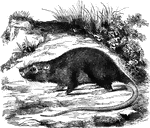
Dactylomys
"It is more than nine inches from the muzzle to the insertion of the tail, and the tail itself is twelve…
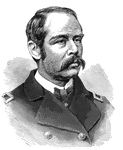
General Francis C. Barlow
"General Barlow, born in Brooklyn, N. Y., October 18th, 1834, was graduated at Harvard in 1855. In 1861…

Confederate Cavalry
"Confederate cavalry driving stragglers and skulkers back to their duty at the Battle of Antietam. One…
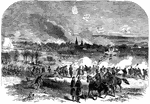
Bombardment of Fredericksburg
"Bombardment of Fredericksburg, Va., by the army of the Potomac, commanded by General Burnside, Thursday,…

Hilton Head
"Exterior view of fortifications erected by the Federal troops at Hilton Head, Port Royal. S. C. Hilton…

Castle Garden
"Reception of Brigadier General Corcoran by Mayor Opdyke and the citizens of New York, at Castle Garden,…

Camp Douglas
"Bird's-eye view of Camp Douglas, Chicago, Ill., used for the detention of Confederate prisoners in…

Mortar Battery Stanton
"Interior of the Mortar Battery Stanton, Tybee Island, Ga., showing the operation of 13-inch mortars…

General Hospital Interior
"United States General Hospital, Hilton Head, S. C., interior. The United States General Hospital at…
Fort Taylor
"Fort Taylor, Key West, Fla. Key West, the most western of the Pine Islands, is about sixty miles southwest…

Battle of Chancellorsville
"Battle of Chancellorsville, Va. Attack on General Sedgwick's Corps. on Monday, May 4th, 1863, at 5…
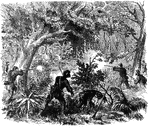
Advance to Vicksburg
"Skirmishing in the woods, on the advance to Vicksburg. Our artist presents a most beautiful scene,…
Fort Vulcan
"Fort Vulcan, Jones's Island, Savannah River, Ga.- one of the Federal batteries cutting off communication…

Fort Hindman
"The investment of Fort Hindman, Arkansas Post, Ark., by the Federal troops under General McClernand,…
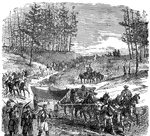
Pontoon Bridge
"The Pontoon bridge 'On The March'- the pontoon wagons on their way from Aquia Creek to the Rappahannock.…

Confederate Batteries
"Fredericksburg, Va., and the Confederate batteries and pickets, as seen from Falmouth Heights, headquarters…

Battle of Gettysburg
"Battle of Gettysburg, Thursday evening, July 2nd, 1863, as seen from Rocky Hill, on Meade's left. Our…

War in Virginia
"The War in Virginia. Capture of three Confederate guns, near Culpepper, by General Custer's cavalry…

Waterhouse's Battery
"Waterhouse's Battery, Sherman's Corps, before Vicksburg. The interior view of Waterhouse's battery,…
Government Buildings - Contraband Camp
"Government buildings for 'Contrabands,' erected at Hilton Head, S. C., in 1862. Among the many singular…

Centreville
"View of the town of Centreville, Va., with the battlefield of Bull Run, Bull Run Mountains, Thoroughfare…

War in Virginia
"The war in Virginia- officers and men of Meade's army discovering unburied Federal dead on the old…

Loudon Heights
"View from Loudon Heights, Va., showing Harper's Ferry, Maryland Heights, Bolivar, etc. Harper's Ferry,…

Fort Walker
"View from the interior of Fort Walker, Hilton Head, S. C. looking inland, showing the defenses from…
Fort Moultrie
"Siege of Charleston, S. C. Bombardment of Fort Moultrie and Batteries Bee and Beauregard by the monitors…

Northern Armies
"The enthusiasm of the Northern armies- re-enlistment of the Seventeenth Army Corps. Financial tests…
War in Virginia
"The war in Virginia. Battery on the left of the enemy's line, in front of Petersburg, captured by the…
Burnside's Corps
"The war in Virginia. Burnside's corps charging the Confederate position on the right of the enemy's…
!["Presentation of colors to the Twentieth United States [African American] Infantry, Colonel Bartram, at the Union League Clubhouse, New York, March 5th, 1864. The Twentieth Regiment, United States [African American] Troops, left Riker's Island at nine o'clock on the 5th of March, 1864, on board the steamer <em>John Romer</em>, and were conveyed to the foot of Twenty-first Street, East River, New York, where they were disembarked and formed in regimental line, and marched to Union Square, arriving in front of the Union League Clubhouse at one o'clock. A vast crowd of citizens, of every shade of color and every phase of social and political life, filled the square and streets, and every door, window, veranda, tree and housetop that commanded a view of the scene was peopled with spectators. Over the entrance of the clubhouse was a large platform, ornamented with flags and filled with ladies. In the street was another platform, tastefully decorated and occupied by prominent citizens. From the stand the colors were presented by President King of Columbia College, who addressed them with warmth and eloquence. After the presentation ceremony was over the men stacked arms and partook of a collation provided for them."— Frank Leslie, 1896](https://etc.usf.edu/clipart/11700/11749/presentcolor_11749_mth.gif)
Presentation of Colors
"Presentation of colors to the Twentieth United States [African American] Infantry, Colonel Bartram,…

Horseshoeing
"Horseshoeing in the army. Not like the country blacksmith, by the highroad upon the skirt of the village,…
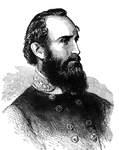
General Thomas J. Jackson
"General Stonewall Jackson, born in Clarkesburg, W. Va., January 21st, 1824, died at Chancellorsville,…

Hooker's Battle
"The war in Tennessee. Hooker's Battle above the clouds, and capture of the Confederate position on…

War in Louisiana
"The war in Louisiana. The army of General Banks crossing Vermilion Bayou, October 10th, 1863. Our artist…

Invasion of Pennsylvania
"The invasion of Pennsylvania- working on the fortifications near Harrisburg, Pa., June 16th, 1863.…
War in Texas
"The War in Texas. Brownsville, occupied by the army under Major General N. P. Banks, in 1863. The sudden…

Fort Stevens
"The operations near Washington, scene of the fight in front of Fort Stevens, July 12th-13th, 1864.…

War in Virginia
"The war in Virginia. General Butler's lines south of the James, Va., with troops in position near the…

Eighteenth Corps
"The war in Virginia. A regiment of the Eighteenth Corps carrying a portion of Beauregard's line in…

Sheridan's Great Battle
"The war in Virginia- Sheridan's Great Battle with J. E. B. Stuart at Yellow Tavern, May 11th, 1864-…

Battle of Ream's Station
"The Siege of Petersburg. Battle of Ream's Station- the attempt of the enemy to regain the Weldon Railroad…

Savannah, Georgia, Looking East
"View of Savannah, Ga., looking east, toward Fort Jackson. Savannah, the entry port of Georgia, is built…

Belle Isle
"View of Richmond, Va., from the prison camp at Belle Isle, James River. Belle Island is situated in…

Confederate Fort
"Ruins of Confederate fort on the southeast side of Atlanta, with chevaux-de-frise and abatis in front."—…
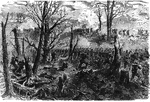
War in Tennessee
"The war in Tennessee. Capture of Mission Ridge, near Rossville, by General Thomas, November 25th, 1863.…
!["Siege of Petersburg- the Ninth Corps charging on the enemy's works after the explosion of the mine, July 30th, 1864. Immediately after the explosion of the mine a hundred cannons opened along the Federal front, and at half-past five the Ninth Corps charged, carrying the fort with a part of the line on each side. The Second Division, which was in the centre, advanced and carried the second line a short distance beyond the fort, and rested, holding ground with the utmost determination. It was at the time the [African American] Division, under General White, was pushed forward and ordered to charge and carry the crest of the hill, which would have decided the contest. The troops advanced in good order as far as the first line, where they received a galling fire, which checked them, and although quite a number kept on advancing, the greater number seemed to become utterly demoralized, part taking refuge in the fort, and the remainder running to the rear as fast as possible. They were rallied and again pushed forward, but without success, the greater part of the officers being killed or wounded."— Frank Leslie, 1896](https://etc.usf.edu/clipart/11800/11856/petersburg_11856_mth.gif)
Siege of Petersburg
"Siege of Petersburg- the Ninth Corps charging on the enemy's works after the explosion of the mine,…
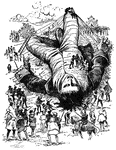
Strapped to ground
A view of Gulliver strapped to te ground with ligatures across his body. With curiosity the inhabitants…

Jackson Hill
"Sheridan's campaign in the valley of the Shenandoah- view of the front from the Federal lines on Jackson…
